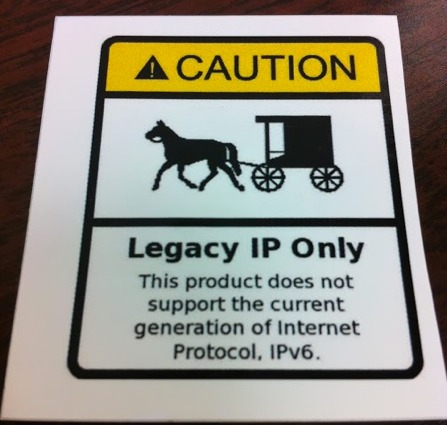Just a guy in Vermont trying to connect all the dots...
Author's posts
Jul 15
Watch “DNSSEC For Everyone – A Beginner’s Guide” Live Today From ICANN47
 Want to understand what DNSSEC is all about? Would you like to understand how DNSSEC helps make DNS more secure? And why DNSSEC is important?
Want to understand what DNSSEC is all about? Would you like to understand how DNSSEC helps make DNS more secure? And why DNSSEC is important?
Today (July 15, 2013) we’ll be streaming the “DNSSEC For Everyone – A Beginner’s Guide” session live out of ICANN 47 in Durban, South Africa. This is a fun session that takes a humorous view on DNSSEC… and includes a number of people (myself included) acting out a skit showing how DNS and DNSSEC work! ![]() Feedback from past sessions is that this all has helped people understand better how this all works – and so we encourage you to watch if you can.
Feedback from past sessions is that this all has helped people understand better how this all works – and so we encourage you to watch if you can.
You can watch the video and slides for the session at:
http://icann.adobeconnect.com/dur47-hall1b
An audio-only streaming option is also available from the session page on the ICANN 47 web site.
The session begins at 5:00pm in Durban, South Africa, which is also 5:00pm in central Europe and 11:00am in US Eastern time.
If you can’t watch the event live, I will be recording the video locally and will post a copy to the Deploy360 YouTube channel as soon as I can.
Jul 15
FIR #712 – 7/15/13 – For Immediate Release
Jul 12
Africa DNS Forum Happening Today And Tomorrow – Live stream / webcast available
 Interested in learning about the state of the Domain Name System (DNS) in Africa? As I mentioned previously, I’m in Durban, South Africa, for the next week for the Africa DNS Forum today and tomorrow and then ICANN 47 next week. The first Africa DNS Forum is happening right now and you can watch live now:
Interested in learning about the state of the Domain Name System (DNS) in Africa? As I mentioned previously, I’m in Durban, South Africa, for the next week for the Africa DNS Forum today and tomorrow and then ICANN 47 next week. The first Africa DNS Forum is happening right now and you can watch live now:
http://icann.adobeconnect.com/dur47-hall1b
The Africa DNS Forum agenda is posted on the AfTLD website and includes these topics:
- Trends, opportunities and challenges of the DNS industry
- Registries Business: Registry Strategies for domain name growth
- Registrar business: Registrar strategies in a competitive environment
- Legal Issues: Cross-border domain registrations
- Registrar Accreditation and accreditation in a borderless environment
- Governments and ccTLD: Supporting the domain name growth
The sessions are happening today, July 12, 2013, from 8:30 – 17:30 and tomorrow, July 13, from 9:00 – 14:00. South Africa Standard Time is UTC+2 which is currently the same time as Central European Summer Time and 6 hours ahead of US Eastern time.
Related to our work here at Deploy360, there will be a section of the first panel on Registries Business that will be focused on DNSSEC and how usage can be accelerated for ccTLDs in Africa. I’m looking forward to hearing the presentations and discussions happening over these next two days – many great and exciting things are happening for the Internet in Africa right now!
Jul 11
First “Africa DNS Forum” To Be Streamed Live July 12 and 13 From Durban, South Africa (Featured Blog)
Jul 08
Comcast Now Enabling Users To Easily Find Out IPv6 Status In Their Area
Are you a Comcast customer wondering when you will ever get IPv6? If so, we learned by way of a tweet over the weekend that Comcast has now made it easy for customers to know if they have IPv6 or will soon be getting it. If you are a Comcast customer, you simply need to go to www.comcast6.net where you will see at the top of the page the current status in your region. Here is a screen shot from one of our team members who is a Comcast customer:
As shown in Comcast’s blog post, if both your regional “CMTS” and your cable modem support IPv6 you will see that you are now using IPv6. If your CMTS (the equipment on Comcast’s network to which your home cable modem connects) supports IPv6 but your cable modem does not, you will see the message above that our team member saw. There is also, of course, a message saying that IPv6 is not yet available in your area.
It’s great to see Comcast making this kind of on-demand checking available for customers and we look forward to day when it is no longer necessary as IPv6 will be fully deployed. Congrats to the Comcast IPv6 team for rolling out this tool!
Jul 08
TDYR #020 – Are You Planning For The Longevity Of Your URLs?
Jul 08
FIR #711 – 7/8/13 – For Immediate Release
Jul 05
The Legacy IP Only / IPv6 Horse And Buggy Stickers – How To Get Copies…
After we tweeted last week about the “Legacy IP Only” horse-and-buggy stickers that we received from Virginia Tech, we had a great number of people asking us about where to get these stickers. As we noted in a subsequent tweet, the source of the sticker is Phil Benchoff at Virginia Tech and the image is available from his Flickr account:
The image was also re-implemented as a SVG file for those who want that image format. Any of the images are available for download so that you can print your own stickers.
For those people interested in actually purchasing a number of these Legacy IP Only stickers, Phil has created an “IPv6 Promotion” community within Google+ to help coordinate bulk purchases… and potentially to help promote other stickers, shirts and products that promote IPv6.
It’s certainly a fun idea and we’re glad to see the sticker out there!

Jul 04
First Africa DNS Forum To Be Held July 12-13 In Durban, South Africa
 What can African registries and registrars do to grow the domain name business in Africa? What role can the African governments play to empower registries and registrars? What can be learnt from successful registries and registrars operating outside Africa and adapted to strengthen their African counterparts? How can cross-border collaborations be setup to strengthen the African DNS Industry? What policies can be implemented to ensure a robust domain name industry? What are the processes that should be implemented to support a structured ccTLD framework? What are the provisions that should exist in order to ensue trust amongst registrants?
What can African registries and registrars do to grow the domain name business in Africa? What role can the African governments play to empower registries and registrars? What can be learnt from successful registries and registrars operating outside Africa and adapted to strengthen their African counterparts? How can cross-border collaborations be setup to strengthen the African DNS Industry? What policies can be implemented to ensure a robust domain name industry? What are the processes that should be implemented to support a structured ccTLD framework? What are the provisions that should exist in order to ensue trust amongst registrants?
These are some of the many questions that are planned for discussion at the first Africa DNS Forum to be held July 12-13, 2013, in Durban, South Africa, just prior to the ICANN 47 event the following week. The DNS Forum is organized by AfTLD and sponsored by the Internet Society and ICANN and is looking to be quite a good event with a program agenda very focused on how to grow business usage of the Internet within Africa.
I (Dan York) will be there attending the event and am looking forward to speaking with people from the region. I’ll be moderating one of the panels and will also be looking to talk to people informally about DNSSEC and how we can get more African ccTLDs using DNSSEC. I’ll also be encouraging people to attend the DNSSEC workshops that will be part of the ICANN 47 event the following week.
If you are already planning to be in Durban for ICANN 47 I’d encourage you to come a few days early and attend this DNS Forum. Registration is open to all interested.


